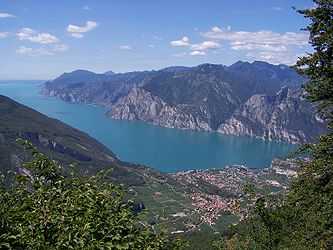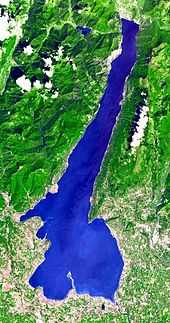Lake Garda
| Lago di Garda Lake Garda | |
|---|---|
 Nago–Torbole and the northern part of the lake | |
| Location | Northern Italy |
| Coordinates | 45°38′N 10°40′E / 45.633°N 10.667°ECoordinates: 45°38′N 10°40′E / 45.633°N 10.667°E |
| Primary inflows | Sarca |
| Primary outflows | Mincio |
| Catchment area | 2,350 km² |
| Basin countries | Italy |
| Max. length | 51.6 km |
| Max. width | 16.7 km |
| Surface area | 369.98 km² |
| Average depth | 136 m |
| Max. depth | 346 m |
| Water volume | 50.35 km³ |
| Residence time | 26.8 years |
| Shore length1 | 158.4 km |
| Surface elevation | 65 m |
| Islands | 5 (Isola del Garda, Isola San Biagio) |
| Settlements | see article |
| 1 Shore length is not a well-defined measure. | |
Lake Garda (Italian: Lago di Garda or Lago Benaco) is the largest lake in Italy. It is a popular holiday location and is located in northern Italy, about half-way between Brescia and Verona, and between Venice and Milan. Glaciers formed this alpine region at the end of the last Ice Age. The lake and its shoreline are divided between the provinces of Verona (to the south-east), Brescia (south-west), and Trentino (north).
Geography
The northern part of the lake is narrower, surrounded by mountains, the majority of which belong to the Gruppo del Baldo. The shape is typical of a moraine valley, probably having been formed under the action of a Paleolithic glacier. Although traces of the glacier's actions are evident today, in more recent years it has been hypothesised that the glacier occupied a previously existing depression, created by stream erosion 5 to 6 million years ago.
The lake has numerous small islands and five main ones, the largest being Isola del Garda. Nearby to the south is Isola San Biagio, also known as the Isola dei Conigli ("Island of the Rabbits"). Both are offshore of San Felice del Benaco, on the west side. The three other main islands are Isola dell'Olivo, Isola di Sogno, and Isola di Trimelone, all farther north near the east side. The main tributary is the Sarca River, others include Ponale River, Varone River and various streams from both mountain sides, while the only outlet is the Mincio River.
If the water level of the Adige river is too high, excess water is diverted to the lake through the Mori-Torbole tunnel.
Towns and villages on the lake
The ancient fortified town of Sirmione, located on the south of the lake, is one particularly popular destination, home to the Virgilio & Catullo Spa Complexes, as well as numerous restaurants, bars, hotels, fashion stores and a market. The picturesque Scaliger castle dates from the 13th century. The Roman poet Catullus had a villa here, and visitors can see a ruined Roman spa named the Grotte di Catullo (Grottoes of Catullus) although there is no evidence linking him to this particular building. The sulfur springs at the tip of the peninsula have a reputation for healing catarrhal conditions, particularly those involving the ear. Nearby, there is Gardaland, one of the most famous theme parks in Italy.

| Trentino-Alto Adige/Südtirol |
Veneto |
Lombardy |
|---|---|---|
| Trentino (clockwise: west to east) |
Province of Verona (clockwise: north to south) |
Province of Brescia (clockwise: south to north) |

Climate
The particularly mild climate favours the growth of some Mediterranean plants, including the olive tree. Citrus trees can also be found, which are extremely rare at this latitude (46 North). This greatly favored the development of tourism since the end of the second world war. In ancient times, poets like Catulle wrote about the "Lacus benacus" (the beneficial lake), with its mild climate vivified by the winds. With subtropical characteristics.
Biology
Salmo carpio, also known as the carpione (carpione del Garda[1][2] or Lake Garda carpione[3]) is a rare salmonid fish endemic to Lake Garda. It has been introduced to a number of other lakes in Italy and elsewhere but unsuccessfully in all cases.[1] The population in Lake Garda has been strongly declining, and is considered critically endangered (IUCN 3.1).[2][3] The main threats are due to overfishing, pollution and possibly competition from introduced species such as Coregonus and Salmonidae.[4]
Adult lake trout outside the mating season are silvery with very few black spots on the body and almost none on the head. During the mating season males develop some a dark mottled body coloration. Garda lake trout reach a length of up to 50 centimeters. They live primarily in depths of 100 to 200 meters. They feed on zooplankton and bottom-dwelling crustaceans in summer. Males and females reach sexual maturity at two or three years. The mating takes place every one to two years. The spawning takes place in 50 to 300 meters depth in the vicinity of underwater springs. The maximum age is five years.[5]
%2C_dettail.jpg)
History
- Battle of Lake Benacus, in which Roman forces defeated the Alamanni on the shores of Lake Garda, in the year 268.
- Battle of Rivoli, in 1797 during the French campaign of Napoleon I in Italy against Austria.
- Battle of Solferino in 1859, during the Italian Risorgimento. The terrible aftermath of this battle led to the Geneva Convention and the formation of the Red Cross.
- As persuaded by the Nazis, Benito Mussolini established the capital of his Italian Social Republic in late 1943 in a villa in the town of Salò on its shores. It served as a nexus for military operations and communications for German troops who occupied northern Italy in late 1943 during World War II.
Transport
Ferry
Regular but infrequent ferry services connect major towns on the eastern and western shores of Lake Garda. The services run in a zig-zag manner from Desenzano del Garda to Riva del Garda (Reiff-am-Gardasee), via Peschiera del Garda, Salò, Garda and Malcesine. One express ferry, on which bicycles are not allowed, operates per day: journey time from Riva/Riff to Peschiera takes 2 hours.
Buses
Buses are faster alternatives to ferry services. On Lake Garda's eastern coast (provinces of Verona and Trentino), ATV (Verona Transport Company) provides at least four daily bus routes between Verona and Garda, with one route extending beyond Garda to Riva/Riff. Trentino Transporti provides daily bus routes between Riva/Riff and Rovereto/Rofreit or Trento/Trient.
On Lake Garda's western coast (province Brescia), Brescia Mobilità provides regular bus services between Desenzano and Salò.
Rail
There are no railway lines connecting Lake Garda. Railway stations with direct bus links include Rovereto (to Riva/Riff), Verona (to Garda), Peschiera del Garda (to Garda) and Desenzano del Garda (to Salò).
References
- ↑ 1.0 1.1 Froese, Rainer and Pauly, Daniel, eds. (2006). "Salmo carpio" in FishBase. April 2006 version.
- ↑ 2.0 2.1 Crivelli, A.J. 2006. Salmo carpio In: IUCN Red List of Threatened Species. Version 2010.1. Downloaded on 2 April 2010
- ↑ 3.0 3.1 S. Melotto, G. Alessio (2006) Biology of carpione, Salmo carpio L., an endemic species of Lake Garda (Italy) Journal of Fish Biology 37, 687-698.
- ↑ Fishing World Records - Salmo carpio Carpione
- ↑ FishBase - Salmo carpio Linnaeus, 1758
External links
| Wikimedia Commons has media related to Lake Garda. |
- VisitGarda is the official website for the promotion of tourism of Lake Garda.
- Brescia Tourism is the official tourism board website of Brescia and Garda Lake.
- Lake Garda at DMOZ
| |||||||||||||||||||||||||||||
| ||||||
| ||||||